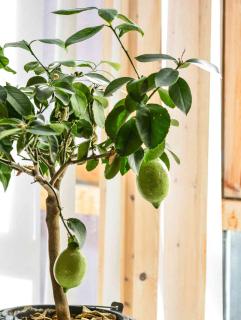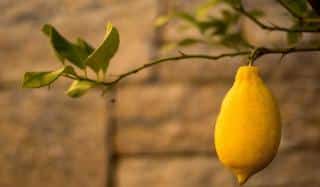

Its tangy fruits are beloved by many, as are its evergreen leafage and fragrant white flowers. Nonetheless, when winter comes, the lemon tree does need special care to winterize it. Discover our tips on winterizing lemon trees.
See also:
 In temperate climates, lemon trees are often grown in pots in most regions. Only along coastlines and in the South is it possible to grow lemon directly in the ground. Indeed, this fruit tree can’t cope with temperatures lower than 40°F (5°C). That’s why this citrus is often grown in containers so it’s easy to bring them indoors over the winter.
In temperate climates, lemon trees are often grown in pots in most regions. Only along coastlines and in the South is it possible to grow lemon directly in the ground. Indeed, this fruit tree can’t cope with temperatures lower than 40°F (5°C). That’s why this citrus is often grown in containers so it’s easy to bring them indoors over the winter.
The lemon tree fears scale insect, red spider mite and aphids. Before stowing it away for the winter, it’s important to check whether or not these pests are present. Look at the underside of leaves and in the water collector underneath the pot. To check if red spider mites are present, mist the leaves with plain water. If droplets condense along thin strands and webs, it means mites are in the tree.
When comes the time to bring your lemon tree indoors, take a few minutes to perform a simple maintenance pruning. Shorten branches that are too long, so that the tree keeps a roundish shape. Cut any branches that touch or cross over each other, and eliminate dead wood if you any.
After settling your tree down in its winter shelter, remember to rotate your lemon tree regularly. This will keep it from growing lopsided. Indeed, even in winter it’ll still try to reach for the light.
 Ideal would be an unheated greenhouse. Lemon trees go dormant at temperatures between 40 and 50°F (5 and 10°C). Favor a luminous and well-ventilated spot, and reduce the watering to only twice a month. If you bring it to place any warmer than that, you’ll have to keep watering once a week, fertilizing it, too, at that occasion.
Ideal would be an unheated greenhouse. Lemon trees go dormant at temperatures between 40 and 50°F (5 and 10°C). Favor a luminous and well-ventilated spot, and reduce the watering to only twice a month. If you bring it to place any warmer than that, you’ll have to keep watering once a week, fertilizing it, too, at that occasion.
If you don’t have a choice, your citrus will have to stay outside. Choose for it a space that’s well sheltered from wind. Best is a warm location in the sun, such as along a South-facing wall. Wrap the pot with styrofoam and place it inside a carton. Add a thick layer of mulch at the foot of the plant. After that, wrap the leafy portion of the tree with two layers of winterizing fleece.
On warmer, sunny days, it’s good for the tree to remove these protections to let the lemon tree breathe and check that all is well.
Only water once a month. Pay particular attention to only water on warmer days. Morning is better than evening, to let the tree soak it up before it gets too cold. If not, the roots might freeze over.
 The hardiest of all lemon trees is the Citrus limon ‘Meyer’. If it isn’t grafted, it can easily take on temperatures as low as 20°F (-6°C). It grows slowly, making it the perfect choice for growing in pots. It bears fruits twice a year: first harvest between October and December and then again between March and May.
The hardiest of all lemon trees is the Citrus limon ‘Meyer’. If it isn’t grafted, it can easily take on temperatures as low as 20°F (-6°C). It grows slowly, making it the perfect choice for growing in pots. It bears fruits twice a year: first harvest between October and December and then again between March and May.
>> Learn more about the different citrus varieties <<
Frost still occurs unpredictably at the beginning of spring. You can bring your lemon tree back outside for good when risks of freezing are over, towards mid-May. First place it in part shade for a few days before transferring it in full sun. Indeed, it’s important to give the shrub a little time to adjust to direct sunlight again.
To learn more, read: